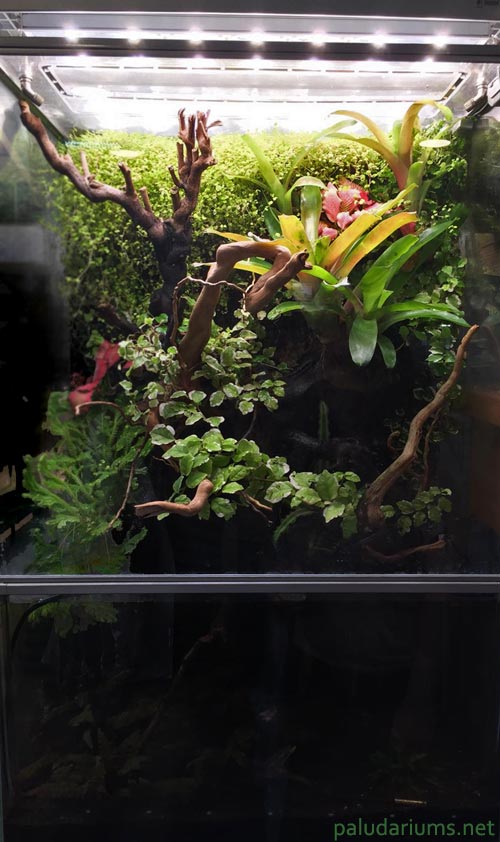

Although they are perhaps more difficult to construct, as a general rule, the maintenance and care of a paludarium is easier than that of an aquarium. It is no coincidence that the establishment and maintenance of such set-ups is gaining momentum, aswell as industry support, alongside the more familiar aquarium and terrarium.
Like any aquarium, you should practise good tank hygene. Adequate aeration, and avoiding fouling by overfeeding are critical. These can lead to outbreaks of algae, mold or fungi, sometimes covering the surface of the substrate. They may not be terminal to plants, though the biofilms can affect gas exchange processes, will slow growth, and certainly look unsightly. These problem are easily solved by removing the upper layer of the substrate, along with the fledging colony of unwanted organisms, and washing thoroughly. Plants should also be well-washed, then transplanted into new soil and pot. But most of all avoid overdfeeding and overstocking.
But creating a decorative paludarium has one bigger problem – the high humidity inside the enclosure. When temperatures differ inside and out, the walls will gather condensation. This is exacerbated by, splashes from waterfalls etc. This can be solved using tanks with strong ventilation or those left partially open, but this often leads to lower humidity inside the paludarium, and naturally precludes certain animal species. Too wet or too dry conditions may harm or even kill the paludarium occupants. A good balance of ventilation, and humidifying from automatic misters/foggers, cloud heads, fountains, streams, etc is essential. In larger tanks, there may well be dryer and wetter zones, suitable for different species, which can be combined in ways not possible in smaller, more uniform displays.
 This Paludarium has a water section below the horizontal join, and a land section above; with a removeable (cleanable!) front glass panel
This Paludarium has a water section below the horizontal join, and a land section above; with a removeable (cleanable!) front glass panelA simple but very handy design is a paludarium with a removable front wall. This makes it easier to care for plants and to keep clean. The most practical material must be silicone glass; it is easily washed and does not warp over time, although fragile and heavier than acrylic / plastic. It should be borne in mind that the greater the volume, the bigger the paludarium, the better the plants do. This is due to more stable conditions and more gradual changes in temperature, humidity etc, when they occur. But keep in mind that you need to match the thickness of glass with the size of the structure. In a large paludarium there should be removable front wall, probably of several parts, and an additional front ceiling glass.
If the paludarium is set on a rack above aquariums, or in a temperature controlled room, additional heating is not necessary. It is necessary to make heating through aquarium temperature or flexible terrarium and weak umps for mixing water and equalize the temperate. Waterfalls can be used to stimulate this. Heating roots are very good for growing plants. The temperature in the paludarium should not be less than 24 to 26 degrees and should not exceed 30 to 35 degrees. If in the summer the temperature rises above, it is necessary to strengthen plant fertilizers and spray. At normal temperature is sufficient to spray plants 2 times a week while when using a weak solution of fertilizer you need to spray ever day, but not increasing the concentration of fertilizers.
The amount of light required will depend very much on which species of animal, but more specifically plant, are being mantained. Light sources should be outside the tank; new LED grow lamps are very, very good; far more efficient than the older flourescent tubes. These lamps have a range of red and purple parts, which enhances the process of photosynthesis, and improves the color of plants, especially the growing red shades. Many paludariums replicate rainforest streams, and do not need overly strong lighting. In such a habitat, natural light is heavily filtered by the forest canopy. The duration of coverage must be within 10 to 12 hours a day. Sometimes if you want to achieve long-flowering light of the day it is necessary to increase the time of the lights to 14 to 16 hours a day.
This wonderful 3 foot wide tank has a waterproof glass bottom, and adequate front window ventilation to keep the front glass clear. Although marketed as a Terrarium, it works as the perfect Paludarium. Front-opening doors, and removeable top for easy access and effective maintenance. Available in a wide range of sizes: with a larger surface area for ground/water dwelling species, or taller for leaf dwellers. Suitable for just about any paludarium inhabitant.
The top is equipped with closable inlets on both sides - this allows access for wires and tubing without offering an escape route for paludarium animals or the tiny invertebrates with which they are being fed. Suitable for powering Heat Wave rocks, waterfalls, filters and sensors, or injecting water through misting systems, external canister filters, etc.
All in all a great enclosure, providing a perfect environment for plants and animals, yet easy maintenance for the paludarium keeper. Available from Amazon and other good pet stores.